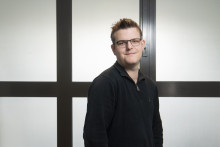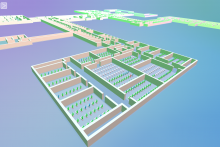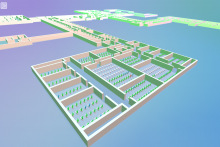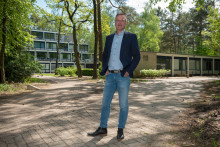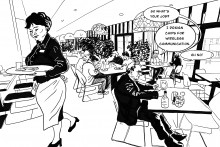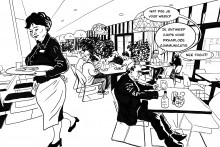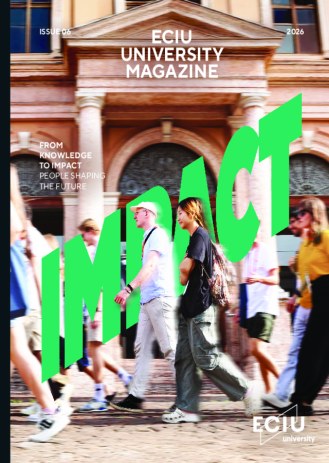‘The biggest fear among firefighters is not burning to death. It is dying due to smoke inhalation because they couldn’t find the exit in time,’ says Benjamin van Manen. Due to extremely low visibility caused by smoke, the doctoral candidate explains, firefighters often must enter a burning building ‘blindly’, risking injury or death.
Benjamin Van manen
PhD research topic: Situational Awareness for Firefighters in Emergencies
Work: Researcher at Saxion & PhD candidate at Department of Earth Observation Science (EOS), Faculty of Geo-Information and Earth Observation (ITC) at the University of Twente
Education: Master’s degree in Systems and Control, University of Twente
Originally from: The Netherlands
‘Which is why the goal of my PhD is to increase situational awareness for firefighters,’ says Van Manen. In direct collaboration with Dutch fire departments, he aims to develop a 3D mapping system for indoor environments filled with fire and smoke.
Underground garages
Although the system should work with all indoor fires, the doctoral research focuses primarily on underground parking garages. ‘It is becoming a big worry for firefighters, because these spaces are very hard to extinguish,’ explains Van Manen.
‘If on fire, such garages have extremely low visibility and no adequate ventilation. Moreover, we increasingly must deal with electric vehicles. While they are usually not the cause of the fire, electric vehicles are extremely hard to extinguish. They can reignite up to forty-eight hours after being extinguished, and so the only truly safe solution is to submerge the vehicle in a container full of water.’
In fact, fires in underground garages are often so difficult to put out that fire departments may decide to let them completely burn out. ‘The commander needs to choose between the safety of the firefighters and material damage. Of course, they will always choose the safety of their people,’ clarifies Van Manen. ‘Letting a garage burn down isn’t always possible, however, because an increasing number of them are located under hospitals, malls, and other buildings.’
Robotics
To provide a truly impactful solution, Benjamin van Manen is working together with several fire departments that already experiment with the use of robotics. ‘It is still a novelty, but there are robots that can create 3D maps before and after the fire. They are often used to map the aftermath for preparing reports, and to investigate the cause of the fire.’
‘There are no robots or technology, however, that can create a 3D map while there is smoke in the building,’ stresses the researcher.
Nowadays, some fire departments use thermal cameras attached to robots to navigate through buildings on fire, but these robots only see and show what is directly in front of them. ‘They have tunnel vision and can’t see what is happening around them at all. Because of this limited visibility, firefighters often follow the robot on foot, which completely defeats the purpose of using a robot in the first place,’ says Van Manen.
3D maps
This is hardly an ideal solution, the PhD candidate points out. Yet, without the use of technology, firefighters must enter the burning building completely blind and improvise their actions on the spot.
‘In my research, we plan to create 3D maps of indoor environments, but also help with map analyses to give the firefighters the most relevant information right away. A map should offer a bird’s eye view of the entire space, and help the firefighters see where all the objects and exits are before they go in.’
To develop the 3D mapping system, the scientist will apply a mix of technology. Sensors like LiDAR and thermal cameras use a longer wavelength that is less hindered by smoke and dust. Additionally, these techniques work regardless of lighting conditions. By coupling LiDAR, thermal cameras, and potentially other sensors with advanced deep-learning algorithms, emergency responders can achieve the global situational awareness they need.
‘Sometimes I get to set a garage on fire’
As a researcher at both the UT and Saxion, Van Manen enjoys that his PhD project bridges the gap between academia and public professionals. ‘It offers a great mix of in-depth research and practical application,’ he says. ‘Sometimes, I’m just working on my computer. Other times, I get to set a garage on fire.’
To test his ideas in practice, the researcher rents out a parking garage at the Twente Safety Campus used for training firefighters. ‘We set it on fire, let the robot in, and collect data. I’m happy to report that no robots have been harmed in getting the data so far,’ he says with a smile.
Once a proof of concept is ready, Van Manen should be able to test it in a real environment with the help of the involved fire departments. ‘However, our solution should also be scalable, so that it can be applied by law enforcement and military, for example,’ he adds.
Slow process
Fire departments are often ‘painstakingly slow’ in adopting new technologies, explains Van Manen. ‘Some firefighters are reluctant to use more technology, because they don’t want their survival to depend on technology rather than their own senses.’
‘My solution, however, would only be used by the commander to prepare a plan of action,’ adds the doctoral candidate. ‘The fire departments are generally happy with the idea, because it would provide them with more information. It is a situation when they must make fast life and death decisions, and they don’t want to find themselves being overwhelmed by data, which is why we also want to help with the processing of the data.’
One thing is for certain, though. ‘Robots will not replace firefighters anytime soon,’ concludes Benjamin van Manen. ‘But they can offer help in environments that are too dangerous for people.’


